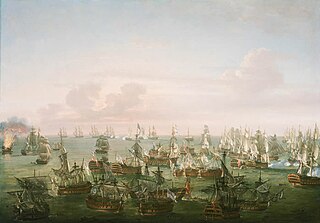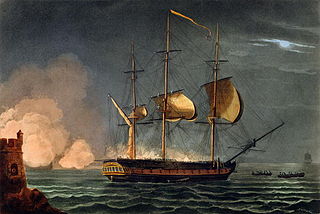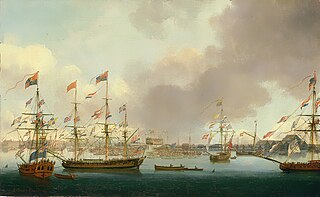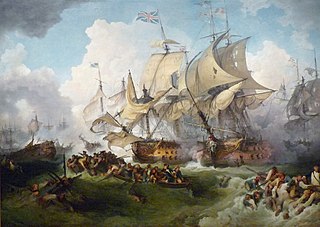
HMS Theseus was a 74-gun third-rate ship of the line of the Royal Navy.

HMS Bellona was a 74-gun Bellona-class third-rate ship of the line of the Royal Navy. Designed by Sir Thomas Slade, she was a prototype for the iconic 74-gun ships of the latter part of the 18th century. "The design of the Bellona class was never repeated precisely, but Slade experimented slightly with the lines, and the Arrogant, Ramillies, Egmont, and Elizabeth classes were almost identical in size, layout, and structure, and had only slight variations in the shape of the underwater hull. The Culloden-class ship of the line was also similar, but slightly larger. Thus over forty ships were near-sisters of the Bellona." Bellona was built at Chatham, starting on 10 May 1758, launched on 19 February 1760, and commissioned three days later. She was the second ship of the Royal Navy to bear the name, and saw service in the Seven Years' War, American Revolutionary War and the Napoleonic Wars.

HMS Mars was a 74-gun third-rate ship of the line of the Royal Navy, launched on 25 October 1794 at Deptford Dockyard.

HMS Hermione was the lead ship of the Hermione class, a six-ship class of 32-gun fifth-rate frigates of the Royal Navy. She was launched on 9 September 1782 at Bristol. Hermione was commissioned and then paid off a number of times during the 1780s. She underwent repairs between October 1790 and June 1792, followed by a period spent refitting at Chatham Dockyard until January 1793. She was recommissioned in December 1792 before sailing to the Jamaica in March 1793. Hermione served in the West Indies during the early years of the French Revolutionary Wars, participating in the British attack on Port-au-Prince, where she led a small squadron that accompanied troop transports.

HMS Alexander was a 74-gun third-rate of the Royal Navy. She was launched at Deptford Dockyard on 8 October 1778. During her career she was captured by the French, and later recaptured by the British. She fought at the Nile in 1798, and was broken up in 1819. She was named after Alexander the Great.

HMS Kent was a 74-gun Bellona-class third-rate ship of the line of the Royal Navy, designed by Sir Thomas Slade and built by Adam Hayes at Deptford Dockyard and launched on 23 March 1762.
HMS Lenox was a 74-gun third rate ship of the line of the Royal Navy, launched on 25 February 1758 at Chatham Dockyard.

HMS Triumph was a 74-gun third-rate ship of the line of the Royal Navy, launched on 3 March 1764 at Woolwich.
HMS Irresistible was a 74-gun third rate ship of the line of the Royal Navy, launched on 6 December 1782 at Harwich.

HMS Nassau was a 64-gun third rate ship of the line of the Royal Navy, launched on 28 September 1785 by Hilhouse in Bristol.

HMS Elizabeth was a 74-gun third rate ship of the line of the Royal Navy, launched on 17 October 1769 at Portsmouth Dockyard.

HMS Venerable was a 74-gun third-rate ship of the line of the Royal Navy, launched on 19 April 1784 at Blackwall Yard.
HMS Alfred was a 74-gun third rate ship of the line of the Royal Navy, launched on 22 October 1778 at Chatham Dockyard.
HMS Repulse was a 64-gun third rate ship of the line of the Royal Navy, launched on 28 November 1780 at East Cowes, on the Isle of Wight.

HMS Queen Charlotte was a 100-gun first-rate ship of the line of the Royal Navy, launched on 15 April 1790 at Chatham. She was built to the draught of Royal George designed by Sir Edward Hunt, though with a modified armament.

HMS Caesar, also Cæsar, was an 80-gun third rate ship of the line of the Royal Navy, launched on 16 November 1793 at Plymouth. She was designed by Sir Edward Hunt, and was the only ship built to her draught. She was also one of only two British-built 80-gun ships of the period, the other being HMS Foudroyant.

Téméraire was a 74-gun ship of the line of the French Navy, ordered in December 1747 to a design by François Coulomb, and built at Toulon by his cousin, the constructor Pierre-Blaise Coulomb; she was launched on 24 December 1749. Her 74 guns comprised:
28 × 36-pounders on the lower deck
30 × 18-pounders on the upper deck
10 × 8-pounders on the quarterdeck
6 × 8-pounders on the forecastle.
Sainte Anne was a 64-gun ship of the line of the French Navy, launched in 1756. She was captured by the Royal Navy on 25 May 1761, and commissioned as the third rate HMS St Anne.
Diligente was a 68-gun ship of the line of the Spanish Navy, launched in 1756.

HMS Dreadnought was a 60-gun fourth rate ship of the line of the Royal Navy, built according to the 1733 proposals of the 1719 Establishment at Deptford, and was launched on 23 June 1742. Dreadnought served until 1784, when she was sold out of the service.
















